by Stacy Whitman, Publisher of Tu Books
I had two Korean roommates in college. Ever since then, I’ve said, “Someday I will learn Korean and visit Hyun Mi in Korea.” Last year, when I made new Korean friends here in New York City, I decided that “someday” needed to finally be today. I started to learn Korean from a book and a podcast, got addicted to Korean dramas, and this May, finally made that trip to Korea I’ve been meaning to make for over a decade.
On my way to Korea, I had a 7-hour layover in London, another place I’ve never seen in person before. I got to meet Cat Girl’s Day Off author Kimberly Pauley, who showed me 221B Baker St. and the whole area around Parliament—Big Ben, the London Eye, and Westminster Cathedral, for example (the outside—no time for the inside), and then we finished off our whirlwind tour with a full English breakfast.
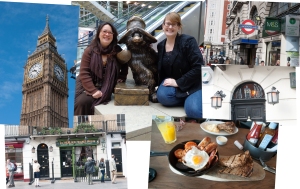
(center) Kimberly Pauley and Stacy Whitman at Paddington Station with Paddington Bear; other sights in London
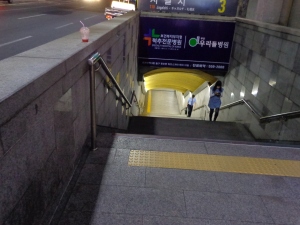
A subway entrance in Busan, South Korea
I didn’t get to visit my old roommate, but I did visit my new friend from New York, who had moved back to Seoul. I stayed with her and her family in Mokdong, a suburb of Seoul, which I loved not only because I was visiting my friend, but also because I got to experience Korean culture from a closer point of view, not as a tourist in a hotel but as a guest. I got to do normal everyday things with my friend, like going to the grocery store and post office, to the bookstore and to the repair booth on the corner run by the ajussi who might know how to fix my purse (sadly, he didn’t have a good solution). I was greatly impressed with the public transportation system, which got me everywhere I needed to be, and often had malls in the stations!
I also met up with the Talk to Me in Korean crew (from whom I’m learning Korean), who happened to have a meetup when I was in Korea. Here I am with Hyunwoo Sun, the founder of Talk to Me in Korean, and his wife, Mi Kyung. A few of us went out for a kind of fusion chicken, the name of which I’ve forgotten, and then patbingsoo—sweet red beans over shaved ice—after the meetup of over a hundred TTMIK listeners.
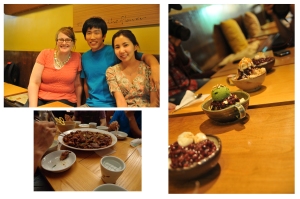
Meet-up with Talk to Me in Korean teachers and students
I love Korean dramas, which are often historical, so of course I wanted to see places like National Treasure #1, the Namdaemung Gate (officially known as Sungnyemun), which burned down in 2008 and was just recently restored and reopened, and Gyeongbokgung Palace in the heart of Seoul. The folk museum was fascinating, letting me see Korean history in person—for example, they had a living replica of a Korean street that brought you forward in time from the Joseon era to the 1990s.
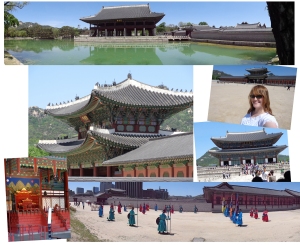
Gyeongbokgung Palace, Seoul, South Korea
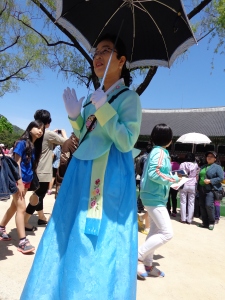
A tour guide at Gyeongbokgung Palace wearing a hanbok, a traditional Korean dress
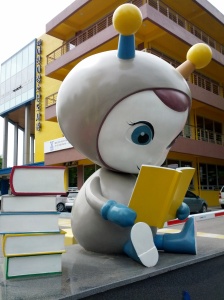
Outside the National Children’s Library in Gangnam, Seoul, South Korea
I also went to the Namdaemun Market, across from the gate, and had my first real Korean market experience, and found a stylish purse. I rode a bike along the Han River (and saw cleverly disguised trash/recycling cans), discovered the national children’s library in Gangnam, watched the changing of the guards at Gyeongbokgung Palace, stopped off for a chocobanana smoothie at Starbucks for a quick wifi fix, wandered around in a park filled with fortune teller booths, got makeup samples in Myeongdong, and found bargains in an underground shopping mall at the subway entrance. What I didn’t do was stalk a Korean drama star, though that was tempting. 
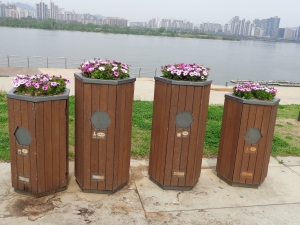
Cleverly disguised recycling
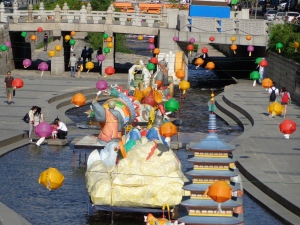
Cheonggyecheon River, Seoul, South Korea
Not too far from the palace was the Cheonggyecheon River, which is a reclaimed river that has been turned into a recreational area. It was my favorite area of Seoul—I loved to walk along it and returned three times while on my way to other places. The first time I discovered it (on the recommendation of Korean American library educator and friend Sarah Park Dahlen), it was decorated for Buddha’s Birthday, a national holiday in Korea. The next day, on Buddha’s Birthday, my Korean host and I went to the local Buddhist temple to discover how the holiday was celebrated among Buddhists, which neither of us are. That night, the Cheonggyecheon was all lit up in celebration.
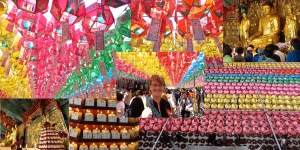
Stacy Whitman at the Buddhist temple in Mokdong, South Korea
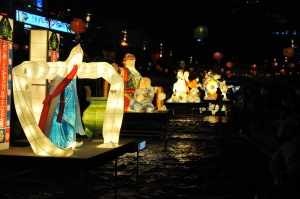
Cheonggyecheon River, Seoul, South Korea
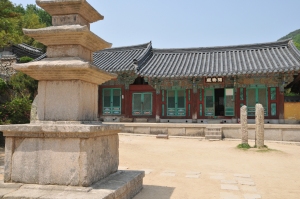
Beomosa Temple, Busan, South Korea
I spent a total of two weeks exploring Korea, the second week of which was spent climbing a mountain on Jeju Island, discovering a Buddhist temple and a famous beach and fish market in Busan, and staying in a hanok (traditional Korean house) in Jeonju—where I also happened upon a famous Joseon picnic spot (Omokdae Terrace, famous for a king having once picnicked there), a famous royal shrine, and a Confucian school where one of my favorite dramas was filmed, and where I saw a delightful sight, a class full of toddlers in hanbok, learning about their country’s history. Jeonju also is the home of a traditional Korean paper (hanji) museum, where they have a hands-on room where I made a sheet of hanji! Later I met the driver of a truck full of garlic, who insisted I take a picture of his truck.
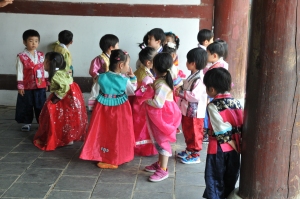
Schoolkids at Jeonjuhyanggyo Confucian School in Jeonju, South Korea

Truck full of garlic in Jeonju, South Korea
Then I rounded out the experience with my friend’s one-year-old’s birthday party in Seoul. (The first birthday is very important in Korean culture, a momentous occasion for which my friend and her husband rented hanbok to wear for family pictures, which I took for them.) However, I didn’t get to the top of 9 km-high Hallasan, the big mountain in Jeju (though I made it 7.5 km!), as I didn’t start early enough in the morning. I’ll just have to go back. Oh darn! (I did, however, get the rare opportunity to see a native deer.)
I ate loads of delicious Korean food, most of which was homemade by my host family, but I also discovered new foods like Jeju’s famous gogiguksu, a pork noodle dish very similar to good ramen. I also had the chance to try Koreans’ interpretation of Italian food, which is very popular—and was very tasty.
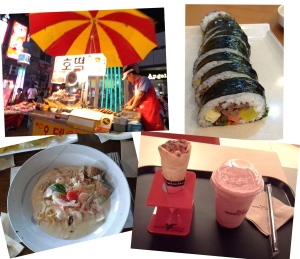
(clockwise from upper left) Korean street food in Busan, kimbap in Seoul, pizza in a cone & smoothie in Jeonju, Italian food in Jeonju
And I took a break from my vacation one day to work, because you can’t publish diverse books and travel halfway around the world and not take the opportunity to meet publishers in the country you’re so interested in. An agent at the Eric Yang Agency was happy to introduce me to several Korean publishers, who were happy to introduce me to their books and to learn about mine. Here’s a picture of the mural in their lobby, a testament to the love of reading in Korean culture and a great riff on the famous photo.
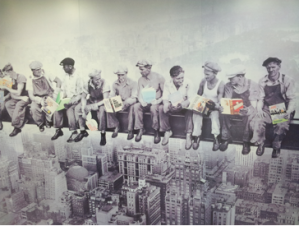
Lunch atop a Skyscraper, now with books!
It was interesting to see how similar and yet different the two country’s publishing styles were—often, we publish similar books, yet we market them completely differently because Korean parents/readers and American parents/readers are looking for different marketing messages in the books they buy. Young adult literature as a category is still relatively new in Korea, particularly in fantasy (though the age category’s storytelling is strong in dramas and manhwa, the Korean form of manga)—the emphasis in Korean children’s book sections of the bookstore is very much on educational supplements. I look forward to someday bringing Korean YA and middle grade voices to a US audience looking for diversity and new stories.
* And it was a bear trying to pare down my pictures. If you’d like to see more, follow me on Tumblr, where I will eventually be posting more pictures a few at a time.
Filed under:
Dear Readers,
DiYA,
Musings & Ponderings,
Tu Books Tagged:
Buddhism,
Buddhist temple,
Busan,
Cat Girl's Day Off,
Cheonggyecheon,
Cheonggyecheon River,
diversity,
Eric Yang Agency,
Gangnam,
gyungbokgung palace,
hanbok,
hanok,
hyunwoo Sun,
Jeju Island,
Jeonju,
kimberly pauley,
Korean,
Korean food,
Korean history,
London,
Mokdong,
myeongdong,
namdaemung gate,
namdaemung market,
publishing,
seoul,
South Korea,
stacy whitman,
Talk to Me in Korean,
traveling,
vacation 

Today is Diwali, a holiday otherwise known as the ‘Festival of Lights.’ In addition, it marks the beginning of the Hindu new year. Though primarily celebrated by Hindus throughout the world, Jainist and Sikh communities also observe this day. Diwali falls in October or November, depending on the Hindu lunar calendar and is a national holiday in countries with large Hindu populations, including India, Nepal, Sri Lanka, Myanmar, Mauritius, Guyana, Trinidad & Tobago, Suriname, Malaysia, Singapore and Fiji. The United States gave the holiday official status in 2007.
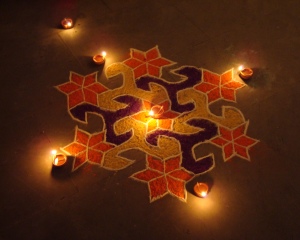
a rangoli or decorative design for Diwali
Diwali is a time to get together and celebrate with family and friends. Homes are thoroughly cleaned, elaborate outfits and fine jewelry are worn, and there is an abundance of food, especially sweets. There are many religious stories and myths associated with the holiday, the most recognized being Lord Rama’s return home from exile after a triumph over the demon Ravana. During Diwali, diyas are lit to celebrate the triumph of good over evil. Diyas are small candles made with a wick dipped in ghee or clarified butter in a clay or brass holder. Hindus place them inside their homes as well as outside on steps and in gardens, to welcome and honor the goddess of light and prosperity, Lakshmi, into their homes. The twinkling lights are symbolic of Rama’s goodness and victory over evil, as well as appreciation for good fortune in life.
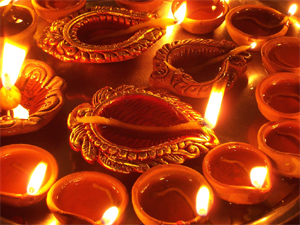
diyas
When I was little I loved Diwali for all the pretty lights, festivities and sweets. Now, it’s all that plus the simple but powerful notion of celebrating and giving thanks for all of the good things I am fortunate to have. Whether you are Hindu or not, it’s a wonderful time to get together with those you love and think of all that’s bright in your life. Happy Diwali to all!
More Holidays
What does Ramadan celebrate?
What do Rosh Hashana and Yom Kippur celebrate?
Filed under:
Holidays Tagged:
Diwali,
diya,
Festival of Lights,
Hindu holidays 

Some of you may be familiar with Diversity in YA (DiYA), a lovely project started last year by authors Cindy Pon and Malinda Lo to bring more attention to diversity in children’s literature. During the year-long DiYA project, Cindy and Malinda were kind enough to do a roundup each month of new titles coming out that featured diversity, and they defined diversity in the following way: (1) main characters or major secondary characters (e.g., a love interest or best friend kind of character) who are of color or are LGBT; or (2) written by a person of color or LGBT author.
Since DiYA is on hiatus, Cindy and Malinda gave us their blessing to continue their monthly roundup. We all felt that it was important to keep the spotlight on diverse books, and we hope you’ll join us in that mission!
Here’s our first roundup: diverse books out this February (if you’re on Pinterest, you can follow the booklist there):
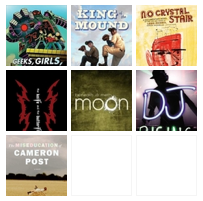
Geeks, Girls and Secret Identities by Mike Jung
King of the Mound: My Summer With Satchel Paige by Wes Tooke
No Crystal Stair: A Documentary Novel of the Life and Work of Lewis Michaux, Harlem Bookseller by Vaunda Micheaux Nelson, illus. by R. Gregory Christie
The Knife and the Butterfly by Ashley Hope Pérez
Beneath a Meth Moon by Jacqueline Woodson
DJ Rising by Love Maia
The Miseducation of Cameron Post by Emily M. Danforth
Read ‘em! Review ‘em! Share the diversity love! Please let us know if we missed any books so we can add them, and keep a lookout for next month’s roundup.
Filed under:
DiYA Tagged:
African/African American Interest,
Asian/Asian American,
Book Lists,
diversity,
DiYA Roundups,
Latino/Hispanic/Mexican,
LGBT,
Multiracial,
Teens/YA  1 Comments on Announcing Our first DiYA Monthly Book Roundup!, last added: 2/10/2012
1 Comments on Announcing Our first DiYA Monthly Book Roundup!, last added: 2/10/2012



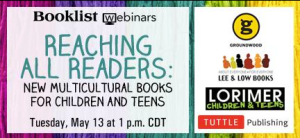


















 Two young-adult fiction authors, Malinda Lo and Cindy Pon, have partnered on the “Diversity in YA” (
Two young-adult fiction authors, Malinda Lo and Cindy Pon, have partnered on the “Diversity in YA” (
I couldn’t make it.